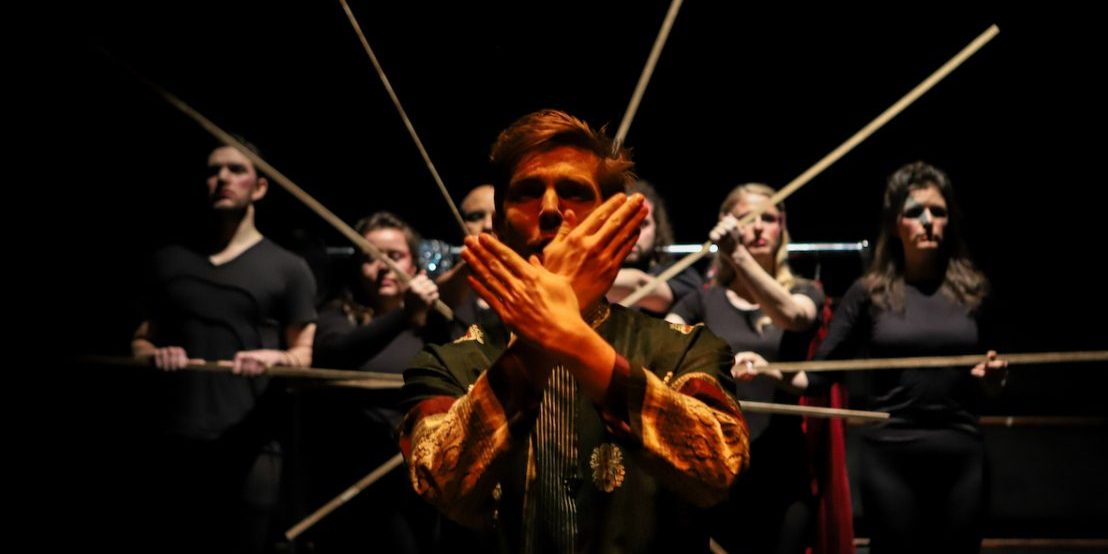Marcio da Silva’s groundbreaking company Ensemble Orquesta (EO) is fast developing an enviable reputation for bringing rare baroque treasures to the opera stage. For this fascinating production he has produced a version of Rameau’s 1735 ‘entertainment’, Les Indes Galantes (‘The Love Islands’ perhaps?). French operas at this point were a rich mixture of myth, singing, dancing, and scenic effects. All the more remarkable then that EO is able to bring vibrant life – with nine singers, seven players, no dancers, and precious little scenery – to this intriguing piece. As ever, the singing and playing are of the highest standard and if some of the stories (the opera is in four parts – a prologue and three “entrees”) don’t quite catch fire, I am inclined to lay the blame on Rameau, who revised the opera repeatedly looking for the right blend.
In the prologue, Hebe, goddess of youth, and Bellone, goddess of war, are in conflict and so Hebe summons Cupid to try to persuade her young followers to abandon dreams of military glory. Cupid gives up on war-like Europe and leads those willing to follow to “the Indies”. The three “entrees” that ensue are musical vignettes that look at love from different viewpoints. The first act – The Generous Turk – tells the story of two lovers who are united because of the kindness of Osman Pasha. This story may be familiar because it was adapted by Mozart later in the eighteenth century. The second act – The Incas of Peru – tells of a love triangle that ends in the union of Phani and Carlos and the death of the jealous Inca priest Huascar. The third act – The Persian Festival – is a comedy about two sets of lovers who are eventually united after mistakes and misunderstandings.
The Cockpit provides a performing area surrounded on three sides by banks of seating – the band is placed at one side of the “empty wall”. The performers all wear black except when they have a specific singing role. For this, they take items of colourful clothing from a rail that is wheeled in at the beginning of each act. All the performers are constantly on stage and those not singing are nevertheless fully involved as dancers or chorus – the repeated “human boat” between acts is both apt and amusing. The scenery, while minimal, is cleverly created by wooden poles, flower petals, and pieces of cloth – once again the shoestring creativity of the EO team is amply demonstrated.
All the singers are on top of the demands of Rameau’s music. I single out four of them with no intention to downplay the ensemble excellence that is achieved. Helen May as Emilie in The Generous Turk is once again superb, with the flexibility of tone and dramatic power that holds an audience rapt – and she is fortunate to have Kieran White as her Valere. His lovely high tenor sounds magical in the shipwreck scene and, in the two gloriously lyrical pieces that end this act, the duet and chorus Volez Zephirs Volez were outstanding. Angela Hicks as Hebe in the prologue and as Phani in act 2 was able to fill the Cockpit with a voice of power and precision that suited both goddess and Inca princess ideally. Act 3 is a comic piece and, though the story was never funny enough to convince, the splendid Poppy Shotts (who was also Cupid in the prologue) was in fine voice. Despite its dramatic shortcomings, it ended with a glorious quartet which left one wishing Rameau had included more ensemble pieces in the opera
Marcio da Silva conducted (and played a number of instruments) and, as ever, brought the best out of his instrumentalists, and his singers. The deftly handled combination of harpsichord and arch-lute gave the recitative the rich undertones that baroque songs so need. I am not sure that on this showing French baroque opera really rivals the best Italian baroque, but we should be applauding the fact that EO is able to bring these rare gems to life on the opera stage.

